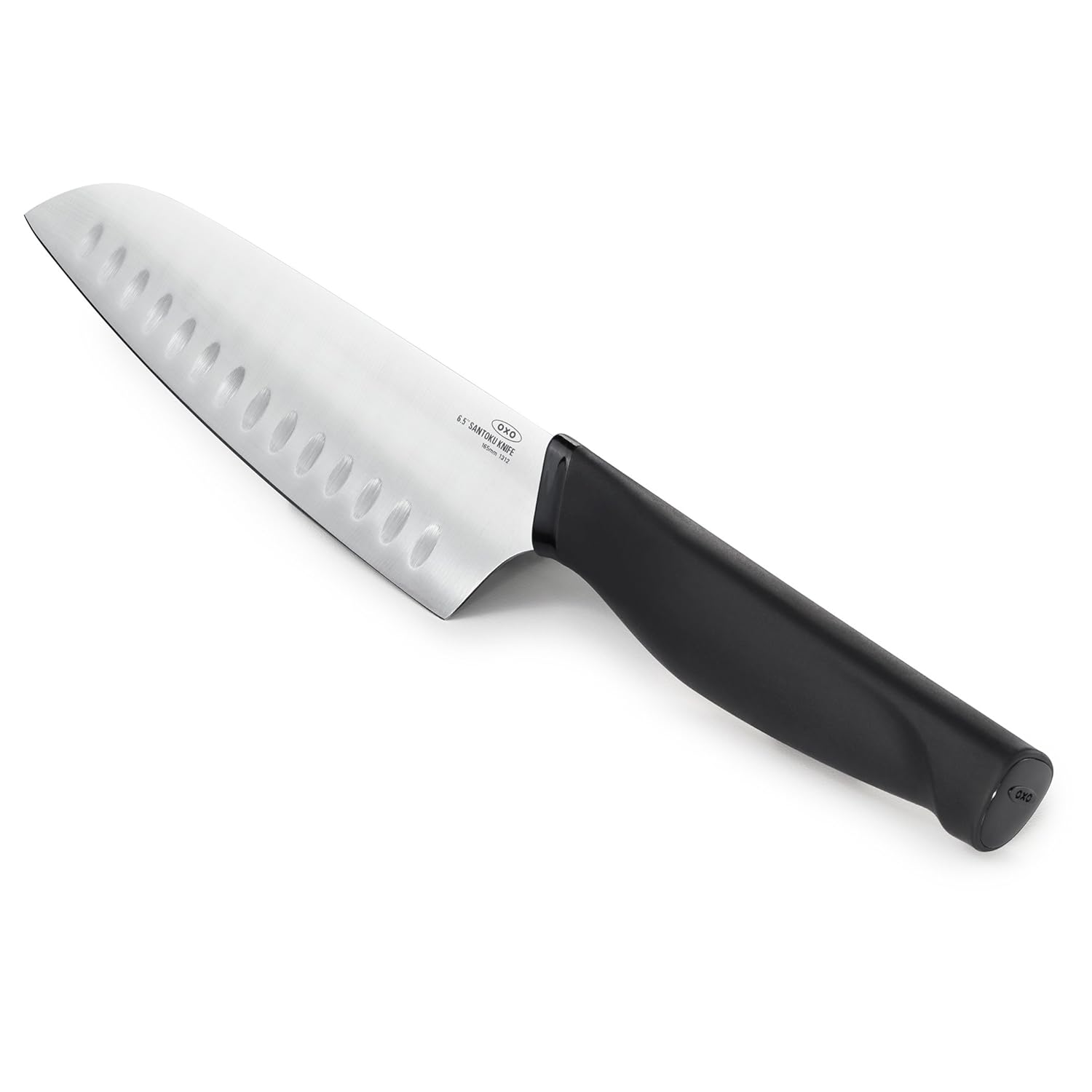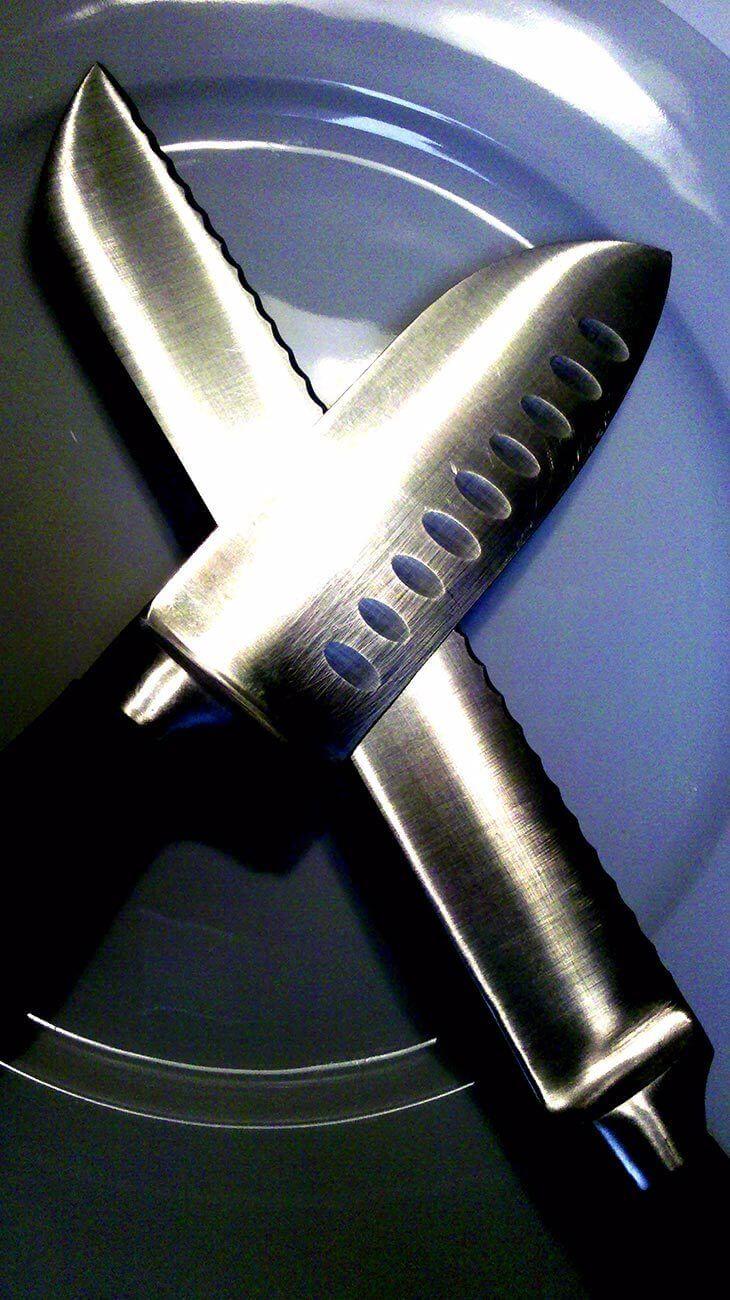Making sushi is an art form. It requires precision and consistency so that your slices don’t come out uneven.
A good santoku knife is essential in making sushi. A good sushi chef should know what brand to use so that his creation will pass the scrutiny of even the pickiest sushi enthusiast.
My love for Japanese food has led me to invest in a wide array of knives and other cutlery. If you’re looking for tips on how to choose the best Santoku knives for making sushi, then you’ve come to the right place.
Top 5 Best Santoku Knife for 2025
| Product Name | Rating | |
|---|---|---|
 | ||
 | ||
 | ||
 | ||
 |
1. Shun Premier Santoku Knife
Via Amazon.com
This Shun Premier knife is a thing of beauty. The intricate design of the blade is not a standard for other brands, and I find that this alone gives this knife an edge (pun intended). However, this santoku is not just beautiful, but extremely sharp, too.
PROS
- checkThis santoku knife is both functional and artistic. It not only looks great, but it also cuts into all types of fish and seafood with ease.
- checkYou don’t need to exert a lot of effort when using this knife. It slices all sorts of meats very cleanly.
- checkI find that this knife has better balance compared to other brands. Because of this, my hand does not tire easily even after cutting through difficult pieces of sushi ingredients.
- checkThe handle’s contour allows a firmer grip while maintaining comfort. It doesn’t hurt that it is beautifully designed, too.
- checkThe blade is very sharp, and it does not chip or scratch easily, even with multiple uses.
CONS
- Understandably, this knife is one of the more expensive santoku knives in the market today.
- I got my knife on sale, so it came in a small cardboard box, which nearly cut my finger when I opened it. Be very careful when handling a newly delivered piece if you don’t want to get into an accident.
2. Global G-48 Santoku Hollow Ground Knife
Via Amazon.com
The Global G-48 is a unique santoku knife because it is made of pure stainless steel, all the way to the handle. This makes the knife lighter than other models. I enjoy using this when preparing a large batch of sushi and sashimi because my hands do not tire as easily because it is so light.
PROS
- checkThe whole knife—both blade and handle – is made of stainless steel. I like this because it reduces the weight that the handle’s material usually adds to the knife.
- checkEven if the knife is very light, it can still cut through my ingredients easily. I don’t need to exert a lot of effort when slicing through salmon or tuna for my nigiri sushi.
- checkThis knife’s razor-sharp edge lasts for months, even with continuous use.
- checkBecause it is so light, I can use this santoku knife to cut thin slices of carrots, cucumber, and other vegetables that I add to my inari sushi.
CONS
- Because the handle is made of stainless steel, I find that it becomes a bit cold to the touch when I have to make sushi in a cold environment.
- While this doesn’t happen often, the handle becomes slippery sometimes so there’s a chance that you could get injured if you don’t hold the knife properly.
- The knife is smaller than other santoku models, so cooks with bigger hands may find it a bit awkward to hold.
- While it is not the most expensive knife out there, the Global G-48 is still a bit pricey, compared to other brands.
3. Wusthof 4183-7 Santoku Knife
Via Amazon.com
While the Wusthof 4183-7 is technically a Japanese santoku knife, it is actually made in Germany. But this doesn’t mean it is less capable of slicing sushi ingredients compared to Japanese-made knives. In fact, I have used this knife to prepare many helpings of California maki before, and the knife worked just fine.
PROS
- checkThis knife is made of high-carbon stainless steel and a polypropylene handle, making it a durable kitchen tool.
- checkThe handle has good form, so it is relatively easy to hold.
- checkAs long as you keep the blade sharp, it is very easy to slice through your usual sushi ingredients, even those that require thinner, straighter slices.
- checkThe price of this Wusthof model falls somewhere in the middle of the knife price range, so it doesn’t put a dent in your pocket when you buy one.
CONS
- While most knives rust if not washed properly, I found that this model is quicker to turn brown when not washed immediately after use.
- I don’t recommend using this knife for heavy-duty chopping or cutting because there’s a possibility that the blade might chip from excessive use.
4. Yaxell Gou 6 ½-inch Santoku Knife
Via Amazon.com
Some people claim that knives are a work of art, and the Yaxell Gou santoku knife is proof of that. The blade is composed of 101 layers of stainless steel, all high caliber, so you don’t only end up with an extra tough blade, but one with extreme beauty, too.
PROS
- checkThe Yaxell Gou wins in design alone. It has a Damascus look that is reminiscent of reputable swords that existed as early as the 18th century.
- checkThe handle is made of black canvas-micarta, which not only provides users with a comfortable and amazing grip but is guaranteed to last for years, too.
- checkBecause the blade is very sharp, you don’t need to sharpen it as much as other knives.
- checkThe blade can cut very precise slices, which is important when you’re making a batch of nigiri sushi that requires the same thickness of fish or seafood.
CONS
- This is one of the most expensive santoku knives I have ever bought. Looking at the design and quality, I’m not really surprised, though.
- You can’t really sharpen it using a regular sharpening tool. You need to use a wet stone and go through the whole process if you want the blade to return to its original sharpness.
- The blade is shorter than a traditional santoku so you need to make more effort when slicing your fish or seafood.
5. OXO Good Grips Professional 6 ½-inch Santoku Knife
Via Amazon.com
If you’re a beginner sushi chef and you don’t want to invest a lot on a knife until you’ve mastered making maki and nigiri, then this knife is the ideal practice knife for you. It’s shamelessly cheap but still promises good quality slicing and cutting, even with multiple uses.
PROS
- checkAt only $22 per piece, this santoku knife is one of the cheapest models available right now, if you’re skimping on the price but still want a decent blade.
- checkIt has a generic santoku knife design, complete with indentations to prevent ingredients from sticking to the knife’s blade.
- checkThe handle is made of soft but durable materials, and is comfortable to hold, especially if you have big hands.
- checkI find that this model is unpretentious. It’s a straight-out santoku knife capable of chopping through all the ingredients you need for your sushi.
- checkBeginners can use this as a practice tool because it is not expensive, but it doesn’t sacrifice quality for the price either.
CONS
- Cooks with small hands may find the handle a bit bulky and hard to grip.
- Because it is relatively cheap, the materials aren’t as high quality as I want them to be. I found that the knife’s edge gets dull easily, compared to the more expensive brands.
- Because the blade is a bit soft, it has a tendency to break easily, if not taken care of properly.
What is a santoku knife?

Now, you might ask: What exactly is a santoku knife? And how is it different from a chef’s knife?
A santoku knife is an all-purpose Japanese knife. It is easy to distinguish from other types of knives because of the hollowed-out indentations, or dimples, on the blade’s edge. These dimples add air between the ingredient being cut and the blade of the knife, so it’s easier to separate the two.
The best way to differentiate a santoku knife from a chef’s knife is by looking at its shape. Where the chef’s knife’s edge is curved, the santoku’s is straight. Also, the santoku’s spine tends to curve down the pointy end, while the chef’s knife has a more pointed tip. Because of this, you have to roll a chef’s knife back and forth when cutting something, but you need to slice up and down when using a santoku.
True to its Japanese meaning—“three virtues”—a santoku knife is usually used for three different cutting styles—chopping, dicing, and even mincing. Because of this, a santoku knife is perfect for cutting small pieces of fish, seafood, and other ingredients used in making sushi.
What makes a best santoku knife?

Not all santoku knives are created equal. To know which brands are better than others, make sure to check out these characteristics:
Blade
A good santoku knife should be sharp enough to cut through any ingredient. It should also be thin and narrow so that the sushi chef can slice through the fish or seafood with ease.
Handle
Because you’ll be using the knife to cut precise slices of seafood, its handle should be gentle on the hands. The grip should not slip even when the knife gets wet. The material of the handle should not add unnecessary weight to the knife either.
Blade Length and Material
A good knife is made of high-carbon stainless steel. This material makes the knife sharp and durable, which are two things you need when making sushi. The blade should also be long enough to glide easily through the ingredient you’re slicing, whether it’s a slice of salmon or a piece of prawn.
Tips to Make Your Santoku Knife Last
Like any other kitchen tool, you need to take care of your santoku knife if you want it to last. Here are some tips on how you can take proper care of your knife:
Know where to cut
Many new chefs make the mistake of cutting their ingredients over a very hard surface. This damages the blade of your knife and causes it to become dull and chipped.
Avoid cutting anything over your kitchen counter or any concrete or glass surface. Instead, pick a chopping board made of hardwood, because wood is generally softer than steel, so don’t make unnecessary damage to your knife’s edge while cutting your food.
Clean your knife after each use
Knives are susceptible to rust, even stainless steel ones. To prevent your knife from rusting prematurely, wash it after every use. Do not leave it unattended for hours, or leave it at the bottom of your sink with your other dishes.
And please don’t wash it in a dishwasher. Hand-wash your knife with warm soapy water, and rinse well.
Sharpen your knife regularly
You don’t need to polish your knife after every use, but you do need to sharpen it once you feel that the blade is starting to get dull.
I prefer using a wet stone to sharpen my santoku knife because I find it produces a sharper and smoother edge. Culinary Arts shares detailed steps on how to sharpen a santoku knife using a wet stone in this two-part video:
What You Need
- 1200 and 4000 grit wet stone
- Nagura stone or low-grit stone fixer
Procedure
Step 1:
Sprinkle water on the wet stone. Sharpen one side of the knife at an angle of around 180 degrees. To do this, lay the edge of the knife against the 1200 grit wet stone and move it back and forth in a diagonal motion, pushing the blade away from you and then pulling it back. Do this for 10 to 15 seconds.
Step 2:
Raise the back of the blade a little to focus on the knife’s tip. Sharpen for another 10 to 15 seconds.
Step 3:
Sprinkle water on the wet stone and flip your blade to the other side. Rotate your wet stone clockwise, about 90 degrees, and sharpen the other side of the knife by pulling the blade toward you and then pushing it away. Do this for 10 to 15 seconds, then raise the back of the blade to concentrate on the knife’s tip.
Step 4:
Rub the nagura stone or stone fixer against the wet stone for a few seconds to touch it up and remove any grooves that were formed during sharpening.
Step 5:
Flip the wet stone to use the 4000 grit. Touch up the surface with the nagura stone. Repeat Steps 1 to 3.
Step 6:
Finish by stropping the knife against the wet stone to remove any remaining residue on the blade.
Conclusion
The Shun Premier Santoku Knife gets my final vote on both design and performance. Not only is the blade’s design superb, its tough stainless steel blade is a treat to work with, too. While the Yaxell Gou 6 ½-inch Santoku Knife is also very beautiful, I find that Shun Premier brand balances the beauty and quality of the blade better.
The Shun Premier may be a bit expensive, especially compared to cheap brands like the OXO Good Grips brand, but I’m always willing to splurge a little if the product is of high quality. And the Shun Premier santoku knife is one such product.































What a great Guide! Very useful when selecting that perfect knife!
Thanks Krysten